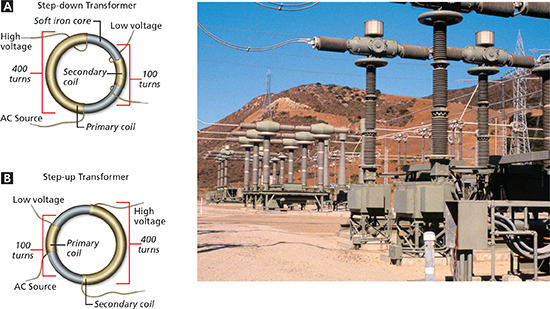Changing Voltage and Current
Figure 16 shows two types of transformers. Notice that each transformer has two sets of coils wrapped around a ring-shaped iron core. When there is an alternating current in the primary coil, the current creates a changing magnetic field in the iron core. Because the iron core is also inside the secondary coil, the changing field induces an alternating current in the secondary coil.
The number of turns in the primary and secondary coils determines the voltage and current. To calculate the voltage, divide the number of turns in the secondary coil by the number of turns in the primary coil. The result is the ratio of the output voltage to the input voltage.
Transformers are very efficient because very little energy is lost as heat. Assuming 100% efficiency, the power (I × V) must be the same in the primary and secondary coils. Therefore, if voltage increases in the secondary coil, the current must decrease in the same ratio.
Types of Transformers
A step-down transformer decreases voltage and increases current. Notice in Figure 16A that the primary coil has 400 turns, and the secondary coil has 100 turns. If the input voltage in the primary coil is 120 volts, then the output voltage is reduced to 30 volts.
A step-up transformer increases voltage and decreases current. In Figure 16B, the primary coil has 100 turns, and the secondary coil has 400 turns. If the input voltage is 20 volts, the output voltage is 80 volts.
Figure 16 Transformers, such as those at substations of power plants, change voltage. A A step down transformer decreases voltage and increases current. B A step-up transformer increases voltage and decreases current.
 d
d



